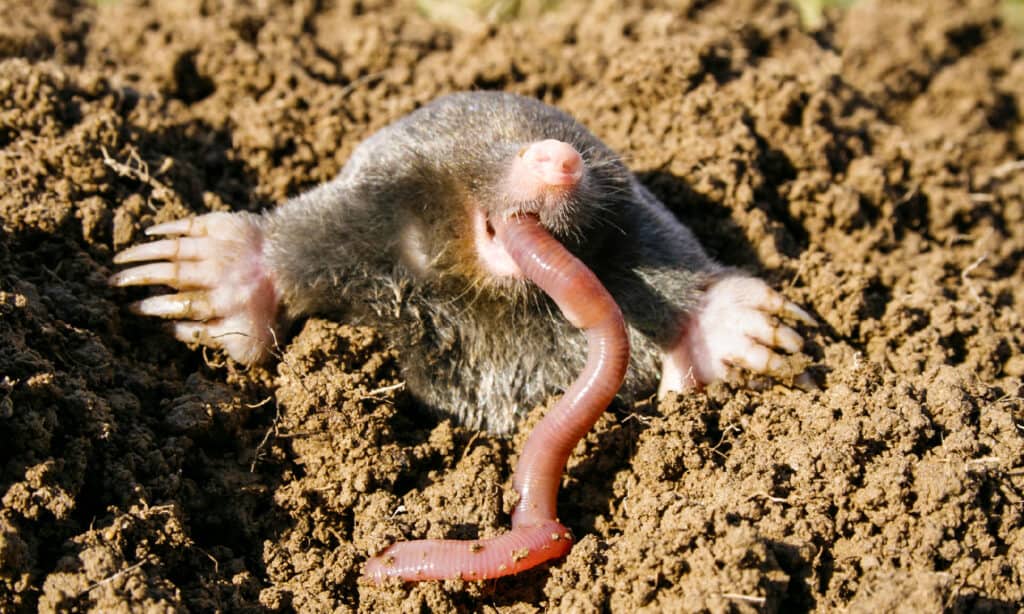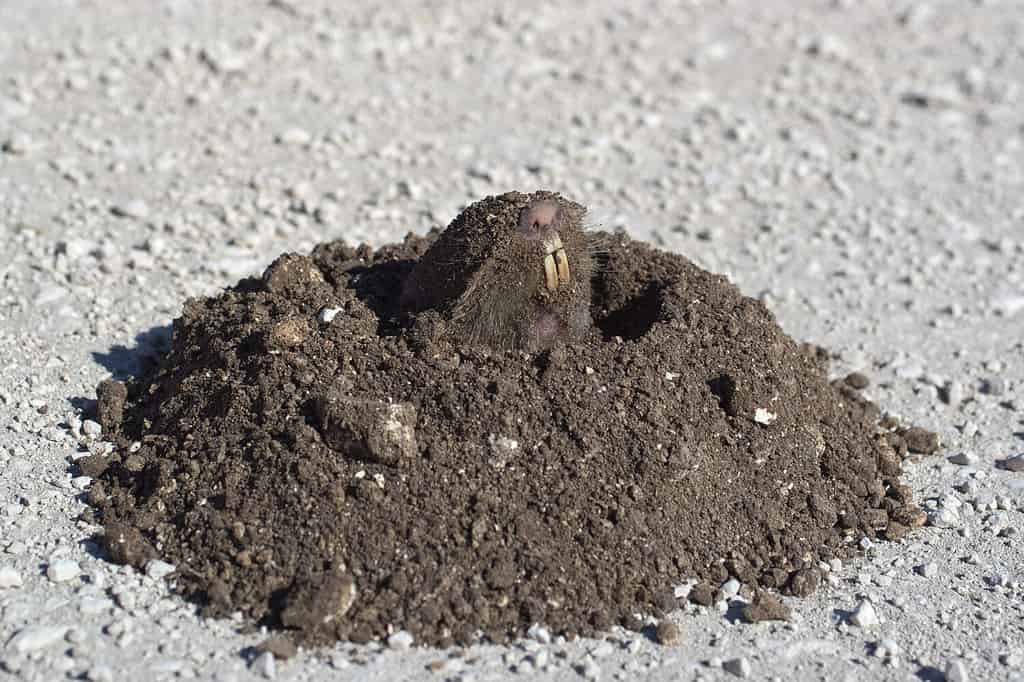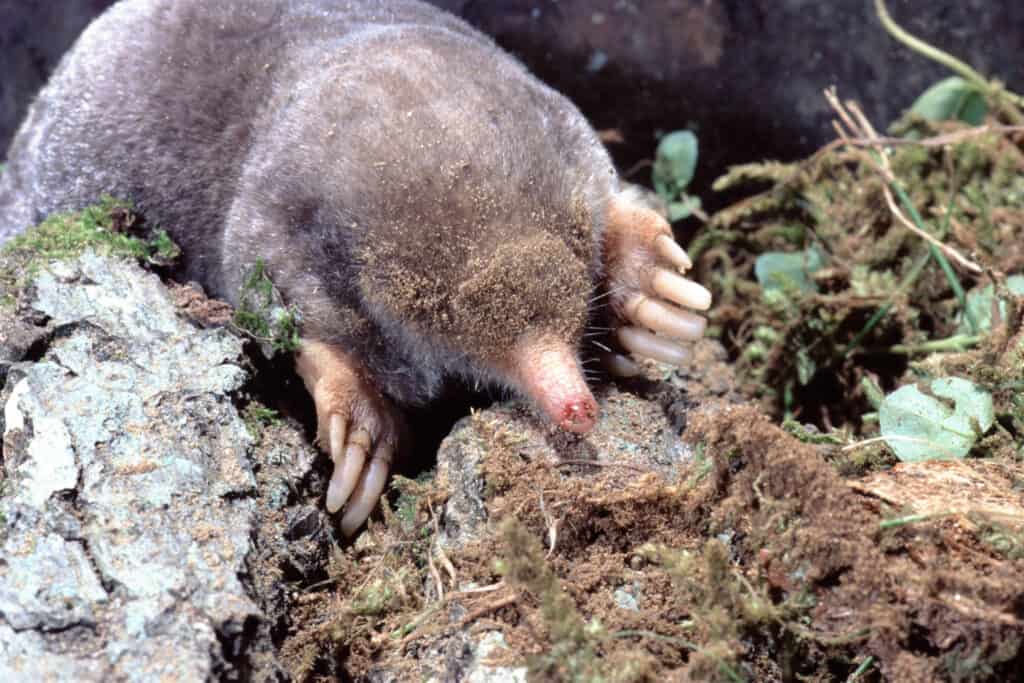You’ve spotted some weird disturbances on your lawn. They’re little hills of dirt left behind by some underground creatures. Moles have discovered your yard and garden, and they are relishing, thinking they’ve found the perfect place to inhabit. They’re going to have to move along but the process of eviction doesn’t have to be cruel. Discover seven effective ways to get rid of moles naturally! Plus, learn more about these elusive underground creatures to better understand how to gently escort them off your property.
7 Effective Ways to Get Rid of Moles Naturally
1. Tackle Their Food Sources

Moles rely on grubs and
earthworms
along with snails and slugs in your soil to survive.
©iStock.com/Tramper2
Moles can’t survive if they don’t have plenty to eat. So, consider removing their favorite source of food. Moles love eating grubs and earthworms. They also snack on slugs, snails, ants, and termites. To reduce their food sources you can introduce nematodes, which are helpful to your garden.
Nematodes are roundworms and they’re small, going unnoticed — for you. However, they are parasitic and have a very specific set of hosts they like to feed on. So long as you select the right type of nematode, you can have them working in your garden for you to reduce the amount of food moles have access to. Once the moles in your yard realize that food is getting scarce, they change their strategy and move to a different location where there is plenty of food for them to enjoy.
2. Spruce Your Garden Intentionally

Adding certain flowers like daffodils can help keep moles out of your yard.
©Andrew Fletcher/Shutterstock.com
Another way to address moles in your garden is to be intentional about the types of flowers you plant. For example, daffodils and marigolds are both a beautiful way to enhance your garden and an excellent way to get moles out of there. These flowers are fantastic because they release a strong fragrance that moles are not fond of. And if you’re already growing fruits and vegetables, these are usually helpful companion plants, which makes it a win-win all around.
3. Try a Catch and Release Method

Moles don’t show themselves often but you can track them, catch them, and humanely release them.
©sergey beryeza/Shutterstock.com
Though this method can be effective, catching and releasing is more difficult and time-consuming. Although you see the molehills, it’s unlikely you’ll see one of the moles tunneling underground. Nevertheless, when you put forth the effort with this method, you get the satisfaction of knowing that they’re actually gone. But first, you have to identify where the tunnels are located.
You do this by first poking a hole to determine if it’s active. If it’s active, a mole will repair that hole within one or two days. Once you’ve identified where that active tunnel is, you can put a trap in there. At this point, you will have caught a mole and then you can release it further away from your home. Give them a good place to tunnel into where they won’t be kicked out again like a shady, wooded environment.
4. Imitate the Presence of Another Animal

Moles don’t like the presence of other animals. If they suspect one is near, they retreat to a more secluded location.
©Liz Weber/Shutterstock.com
No, we’re not saying to get out there and start digging in your own yard on all fours. Use technology to help out with this task! There are non-invasive repellents you can use to keep moles away from your yard. For example, you can try a solar-powered option that is designed to emit vibrations underground. The moles interpret this low-frequency vibration as another animal in what they’ve established as their own territory.
They may consider it a competing animal, or they may think that a predator is out to get them. Moles are like introverts. They don’t particularly like sharing space with others and would rather retreat to a place where they can be alone. Additionally, moles aren’t very persistent. They’re great at what they do when it comes to tunneling but if they perceive that the environment is not ideal for their presence, they move along rather quickly.
5. Dig to Create a Barrier

You could dig a barrier around your garden or other plants you wish to protect from moles.
©Ozgur Coskun/Shutterstock.com
Okay, this method does require you to do a little digging. But you can use a shovel (or just outsource the task!). For this method, you dig a trench that’s about six inches wide. Sounds simple enough, right? But here’s the kicker: it does have to be at least two feet deep. It’ll take a minute! However, it’s effective if you have a certain area of your yard like a garden that you want to protect.
You’re basically creating a barrier all around your garden to keep those burrowing moles from ruining your work. Once you dig the barrier, you can fill it in with rocks. This can add a decorative element depending on the types of rocks you choose but it also serves a practical purpose.
6. Change Your Lawn Watering Frequency

Watering less can help deter moles from your yard as it decreases their preferred conditions.
©iStock.com/MaYcaL
When you keep the kind of lawn and garden you’re proud of, you know how much care it takes. Part of that care involves watering. However, moles love a moist environment. Soft soil is their dream. Instead of overwatering, cut down on your watering frequency.
With this change, moles will interpret it as drought conditions and move to a better-suited environment for their needs. This has a two-fold effect because earthworms also prefer moist environments and when you reduce the amount of water that goes out to your lawn, they’re not as active, which also lets moles know they need to find a better spot for their survival.
7. Tidy the Area

Clear your yard to remove any unnecessary items or clutter that provide them with extra cover.
©1000 Words/Shutterstock.com
Moles like to stay underground and undercover. If you have different items littering your lawn, tidy them up. Keep the area clean and well-manicured so that moles don’t consider it a good place to call home.
More on Moles
Moles are small mammals that are known for burrowing in the ground. They’re not quite as inconspicuous as they think they are because they end up creating mounds all over your yard with their burrowing behavior. They’re not fans of the light of day and spend most of their lives living underground.
Their tunnel systems are complex and allow them space to forage or nest. They’re only about four to eight inches long but their tails extend a little further. Since they don’t need sight to navigate, they have very poor vision. Instead, they lean into their other senses to help them navigate and survive.
They have claws that work like shovels, which is crucial since their primary activity is digging. Although you see only the aftermath of their digging, their tunnels include different chambers dedicated to specific purposes. For example, they may designate a chamber specifically for storing their food or for raising their young.
How Moles Damage Your Yard
Moles move quickly, able to create a tunnel that spans up to 160 feet long. And they do this in a single evening! Because of this, they can do a lot of damage to your yard and garden in the form of molehills. This is not at all their intention as they’re just living in the only way they know how but there are some consequences to their otherwise regular behavior.
Even though they do damage gardens and lawns, they are important to the ecosystem because they help to eliminate insects as well as aerate the soil, which are both helpful consequences. Nevertheless, when you’re working on your lawn and garden, you certainly don’t want to deal with moles ruining something that takes time, effort, and funds to upkeep.
Methods to Avoid
A popular go-to, seemingly ‘natural’ method is the use of castor oil. However, this does nothing to repel moles and instead harms these small mammals. Moles don’t need to experience pain and discomfort to be deterred from your yard. Another method people resort to is the use of mothballs. However, these do more damage, and rather than solve your mole problem, just mask it as moles create alternative tunnels when they sense the concentrated pesticides. This last one should go without saying but baiting by using poison should be avoided. Not only is this cruel, but it also poses a risk to pets, children, and other small animals in the area.
The photo featured at the top of this post is © Ondrej Prosicky/Shutterstock.com
Thank you for reading! Have some feedback for us? Contact the AZ Animals editorial team.







